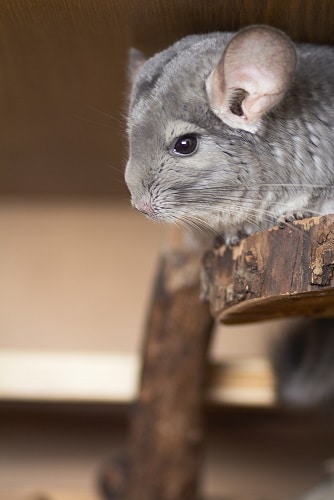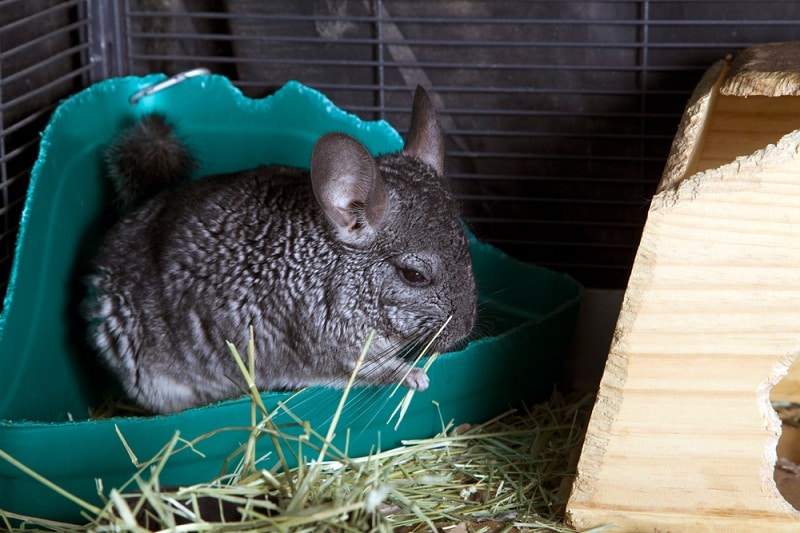
Misinformation and Care Myths Index
Care myths are something like urban legends in the way they work, especially in their evolution and widespread impact. Usually, the intent is good, people passing along advice because they want to help others, but when the information itself is flawed (completely false, partly true or true but intended for a different species) or when the person relaying it misinterprets or misapplies it (either through arrogance or accident), then the results can be disastrous for the lives at stake unless the chinparent stops first to think critically and ask questions of the source. ANY source.
For instance, there has not been a lot of scientific research done on chinchillas for the benefit of understanding them as pets. If anyone makes scientific claims or calculations and presents them as if they are established “chinchilla fact,” then they need to be held accountable for disclosing the origin of their information. It doesn’t matter how many “years of experience” they may have with chins, if they’re quoting some other species’ research information in the context of a chinchilla-related discussion, or on a chinchilla-related site without crediting sources or explaining that an extrapolation (speculative projection of information from one species onto another) has been made, that is FRAUDULENT.
The myth of Hepatic Lipidosis is one example of faulty extrapolation, another is assuming that chinchillas have an atypical calcium metabolism like rabbits and guinea pigs which predisposes those two species (but not chins) to bladder stones. Chinparents NEED to know the whole truth about the information they get, its origin, how any calculations or conclusions being asserted were arrived at, and whether they have been proven or are only speculative, etc.
Care myths and misinformation can be found everywhere, from online pet sites to pet chinchilla care books, but it seems that some forums are especially rife with unsubstantiated information, opinionated assumptions, misleading oversimplifications, etc. Many of the myths we encountered (and naively believed) as far back as 1997 are still in circulation. It’s taken years of gathering knowledge and practical experience for us to get a real understanding and perspective on things, which underscores just how important it is for every chinparent to stop, think critically and ask questions FIRST before proceeding to act in their chin’s best interests:
- Alfalfa hay – not bad for chins, when served 2-3 times a week its high calcium content can help prevent a malocclusion
- Allergies – “no dander” does not mean “hypoallergenic”
- Anesthesia – not a “death sentence”
- “Anorexia,” and “fattening” small chins – read first about the two different body types (scroll to view)
- Anti-fungal powder – not necessary as fungus prevention
- Bladder stones – unlike rabbits and guinea pigs, chinchillas are not prone to bladder stones from “excess calcium”
- Bonding – being “hands-off” with a new chin can backfire and make for one fearful, anxious or anti-social chin
- Breeding/mating myths – some revelations
- Cages – ferret and rabbit housing often unsuitable
- Cardboard – cheap and convenient but not good for gnawing
- Catching – as prey animals chins typically avoid “capture,” but this doesn’t mean they shouldn’t be caught and handled
- Change – chins require time to adjust to major change and first reactions are not always indicative of likes/ dislikes
- Chincha/Chinta – no such thing as Chinta Indians, this mistake is probably due to “ch” sometimes sounding like “t”
- Dustbath – no need to withhold
- Eating – chins do not need to eat continuously to avoid GI stasis or Hepatic Lipidosis
- Exercise – under normal precautionary circumstances, is absolutely not “dangerous” and doesn’t need to be limited
- Eyes – wet eyes do not always indicate malocclusion
- Groups – male groups, and female groups can coexist in the same household, with precautions observed
- Hairballs – unlike with rabbits, hairballs are extremely rare in chins, preventative treatment is unnecessary
- Hunchback – not a condition in itself, this is a sign of significant weight loss that can be caused by various conditions
- Lanolin – chinchillas are not wool-bearing animals, they do secrete oil from their skin, but it’s not lanolin
- Malocclusion – not always a “death sentence,” is sometimes treatable and reversible
- Masturbation – it might look that way, but actually he’s only cleaning himself or trying to remove a hair ring
- M.F. Chapman – read about the hoax
- Neutering – not “certain death”
- Pellets – should not be rationed and can be refrigerated without worry, cold food does not cause seizures
- Products – it says it’s “for” chinchillas, but it may still be harmful
- Quarantine – not a perfect guarantee of good health
- Relating – why it’s often better not to “let the chin come to you”
- Same-sex pairs – both M/M and F/F can cohabitate, it is not true that males can never cohabitate as adults
- Stress – not all chins are of the calm, easy-going and well-adjusted type, chins, in general, are sensitive to stress
- Sunlight – in itself, is actually good for chinchillas, but the heat generated from direct sunlight can kill them
- Tap water – does not contain “nutrients” but may contain contaminants and parasites
- Treats – don’t help weight gain but can seriously injure health
- Vegetables or “Greens” – unlike rabbits and guinea pigs, chins don’t need fresh greens, it puts them at risk for bloat
- Wet baths – not “certain death,” sometimes necessary
- Wheels – chinchillas will not “run themselves to death”
- Wild chinchillas – not the same animal as a Viscacha
The Essentials, Or Basics, Of Chinchilla Care
The document version of this section and our Disaster Response sheet is available for use per our Copyright Notice
Vet care
It is absolutely necessary that a chinparent researches in advance and keeps on hand the information (name, location, office hours, after-hours emergency facility, etc.) for a nearby exotics specialist veterinarian. Chinchillas don’t require check-ups (or vaccinations) after their initial vet examination (when they’re brought home for the first time), but we strongly advise getting a yearly head x-ray because that is the only way to confirm and address malocclusion at the earliest stage. In the event that there are adverse changes in the chinchilla’s health maintenance indicators, the expert care of an exotics specialist vet is required; this underscores the importance of keeping an emergency fund in preparation for such a situation
The following must be available at all times, do not ration, these will not be over-consumed:
Fresh pellets made specifically.
Distilled or filtered water.
A variety of fresh hays to encourage consumption and to keep continuously growing molars ground down.
A variety of safe, effective chew toys of varying hardness, to encourage gnawing interest and to keep continuously growing incisors trimmed.
An indoor, temperature-controlled environment that does not exceed 70 degrees Fahrenheit!
The temperature in a chin’s environment should never exceed 70°F, at 80°F they’re facing brain damage, heatstroke, and death. We concur with New Hope Animal Hospital: “Ideal conditions are 60°F to 70°F with a humidity level of 40% to 60%.” (ref– New Hope Animal Hospital)
An environment that is safe, moderately active, and allows for sufficient daytime rest.
Many items marketed “for” chinchillas are in fact harmful, even lethal: wheels with spokes, plastic cage parts or accessories, and cedar bedding to name a few. Chinchillas need a moderately active environment, one that provides enough exercise, activity, and interaction to prevent boredom (a variety of chew toys, a cage wheel, and TV during waking hours provides environmental stimulation) but not so much as to overwhelm them with environmental stress factors. Chinchillas are chiefly nocturnal but can be crepuscular, i.e., active at twilight in morning and evening. Sufficient daytime rest includes having a hideaway (tube, hammock, house- no plastic- and one hideaway for each cohabitating chin can help prevent cagemate conflicts) in their cage as well as a cage location that is relatively quiet and secure (away from prying pets, excessive household traffic) so as to be conducive to daytime sleeping.
Regular out-of-cage exercise and bonding time, an exercise wheel for inside the cage is also strongly recommended.
Exercise directly impacts chinchilla health and longevity, it’s also the best time to bond with your chinchilla.
Fresh chinchilla dust bath offered in an appropriate container.
Cage Accessories should never be made of plastic or other hazardous material. Chins need at least these two accessories for their cage:
- A hideaway to relax and sleep in such as:
- Wooden house, for example: Chin Hut, XL Woodland Get-A-Ways, Link N Lodge, Large Tropical Hide Outs
- Ceramic container or metal tube (pointy edges sanded down)
- Cloth hideaway, for example: The Day Bed, hammock, Cuddl-E-Cup with the strap removed, Comf-E-Cube. Chins do appreciate the soothing comfort of cloth (photo below), but it should have no strings, fringe or loose weave to avoid problems associated with accidental ingestion
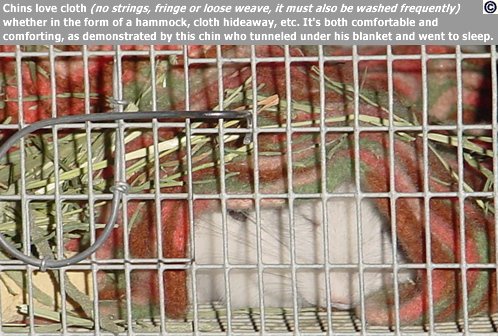
2. Something to relieve the constant pressure of standing on wire mesh, such as a mat made of natural material like seagrass or maize (mats are great in hideaways that have no floor), a large wooden shelf or perches, or a pillowcase folded in half and placed under their hut.
There should be a hideaway for each cohabitating chin because sometimes even bonded pairs need their own space.
Housing big enough to accomodate running and playing, the larger the cage, the better, in height as well as width!
Does a cage HAVE to be large? YES!!
You can tell the difference between a prison cell and a home, and so can your chin! Failure to provide a large cage can result in health and behavioral problems, the small battery cages used on fur farms are no measure of what a pet chinchilla cage should be.
See Martin’s Highrise at 30″x 18″x 48″, THAT is a cage large enough to suit one, at most two chinchillas. Quality Cage Company’s Chinchilla Mansion at 30″x 24″x 48″ will comfortably accomodate two chins and Martin’s Townhouse at 36″x 30″x 60″ can house up to four. Never overcrowd a cage, that can cause fighting as well as serious health and behavioral problems. It is generally inadvisable to keep more than four chinchillas in one cage.
Unlike some other caged pets, chinchillas use their cage walls for jumping on, springing off of, and running against as they play. Most pet store cages do not feature safe mesh width, that is, a mesh size small enough to prevent foot and leg breaks. Cages with safe mesh width (1″ x ½” -OR- ¾” x ¾” for the cage walls and ½” x ½” for floors, shelves, and ramps) tend to be either homemade or ordered online. Ferret or rabbit cages are usually NOT suitable for chinchillas, due to overall size (too small) or mesh width (too large).
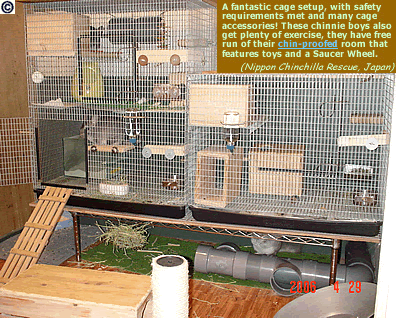
In our opinion, the two best cage suppliers, which ship worldwide and have all-metal, galvanized, and safe mesh width cages, are:
- Martin’s Cages: the Townhouse or Highrise sizes
- Quality Cage Company: the Mansion or Townhome sizes, just be sure to get the 1″ x ½” mesh on the sides when ordering, for safety reasons, not just for containing kits.
Cages can be tall, height isn’t a problem since in the wild they traverse the Andes mountains by jumping between rocks over rough terrain (chins are rockhoppers in the wild!), however, it IS important to space shelves and perches (no plastic!) so that they can land or catch their balance before taking off again. Females that are near their birthing date or are nursing must be housed in a single level cage to prevent climbing, curious kits from experiencing accidents.
Ramps may or may not be advisable depending on the cage size, layout, health, handicap, and age/ eyesight of the chin. In a large cage where shelves and perches are placed in a way that facilitates navigation, then ramps would indeed just take up space and get in the way, even more so with a smaller cage. However, when a chin has poor health, is lame or handicapped, or is older and has diminished eyesight, then ramps provide a necessary navigational advantage.
As mentioned previously, chinchillas need an INDOORS, temperature-controlled environment, and thus the chin’s cage must be located indoors. Place the cage in a location where the household noise and traffic is minimal and other pets won’t pry while the chin is trying to sleep during the day. There should be plenty of ventilation and air circulation but not drafts such as would occur near an outside door. It should go without saying that an aquarium-type housing arrangement is totally unacceptable, the glass dangerously amplifies heat while denying sufficient air circulation.
Positioning the cage securely on a sturdy table, stand or something that can raise it to the height of approximately your eye level is a very good idea, because as small animals of prey, the advantage of height makes chinchillas feel empowered, safe, and on a more equal and amicable standing with their chinparent.
The cage must NOT be located where the chin is constantly exposed to direct sunlight. Sunlight itself is good for chins, in fact, they’re known to sun themselves on rocks in the wild. HOWEVER, in the wild, they can get up and walk away when direct sunlight increases heat intensity beyond their ability to cope, whereas in captivity they are not in control of where their cage or carrier is placed. So be advised, sunlight is GOOD for chins just as long as it is not direct sunlight that is ALSO capable of causing an increase in heat intensity.
Exposure to excessive household chaos, marauding pets, direct sunlight (as described above), insufficient air circulation and overcrowding, etc., MUST be avoided because these things can cause heatstroke, anti-social behavior, fungus, fur biting, and other stress and disease-related problems.
Your chinchilla’s cage must be cleaned when you first get it before it’s put to use. After that, it should be cleaned a minimum of once weekly. Chinchillas in good health have odorless fecal droppings and urine, but the urine will gather odor if the cage is not cleaned regularly.
Baby cornstarch powder or Arm & Hammer caking soda (no baby powder, nothing containing talc!) can be sprinkled in pee corners to keep things fresh provided that the chin doesn’t take an interest in eating the baking soda (tastes of salt, try cornstarch powder instead) or sticking his face into the pee corners continually, which could result in fungus.
Cages with solid flooring, where the chin is in regular contact with his bedding, will need that bedding kept fresh and the flooring kept continually clean and disinfected. Cages with a pull-out litter pan that keeps the chin above his litter and mess but that necessitate a wire mesh flooring may be objectionable to some people who prefer all solid flooring, but in any case, neither flooring has a bearing on the prevention of callouses or Bumblefoot. Wire flooring makes it especially important that shelves, mats, etc. are provided for relief from the pressure of standing on wire mesh.
If cleaning the cage at home, say, in your home’s bathroom shower stall or in your backyard, be sure to disinfect it first by scrubbing the cage vigorously with a brush soaked in a pet-safe cleaner, then hose it off thoroughly with hot water from your shower attachment or garden hose. We used to take our cages to the self-serve car wash, just be sure that if you choose to lather and scrub your cage there that it gets rinsed VERY thoroughly afterward. A cage must be dried completely before returning the chin to it, otherwise, a damp corner can host mold, i.e., fungus.
Cage Safety Issues
We advise covering cages with a sheet for the following reasons:
The sheet will help contain mess and dust, and it makes a barrier between cages to prevent knowledge of (and contact with) the opposite sex or other chinchillas right next door. This is a PROXIMITY and SIGHT (not scent) issue; seeing other chins across the room or more than a few feet away is normally not a problem, but seeing them camped right next door often is and this can result in territorial anxiety (and excessively marking territory with urine), persistent or aggressive dominance mounting that can lead to cagemate conflicts, or anti-social (biting, urine-spraying) behavior that some chins may direct at their chinparent to convey their extreme stress and agitation.
Perhaps most importantly, covering the cage provides some privacy and seclusion which reassures the chin (especially high-strung chins) that the area within their domain is protected and secure; this is essential for daytime sleeping. Throughout our years of rescue work we’ve taken in chins that were high-strung, severely stressed, and fur-bitten that made rapid improvement due in large part to simply having their cage covered. When a small animal of prey feels trapped, overly-exposed, and vulnerable, it can be a stress factor.
Safe mesh width is 1″ x ½” -OR- ¾” x ¾” for the cage walls and ½” x ½” for floors, shelves, and ramps. Anything smaller than that is fine, but anything exceeding that size is extremely hazardous!!
Chinchillas aren’t like some other pets, they don’t just sit placidly in their cage, they like to run along and bounce off the cage walls and if the mesh width is too large, it can easily snap their thin, fragile leg or foot bones when they go right through it.
Accidents caused by unsafe mesh width are not uncommon and the consequences are severe and costly to both chin and chinparent, typically resulting in amputation or death from acute shock if the problem goes undiscovered and the chin is left dangling by the trapped limb for hours. Safe mesh width isn’t just important to those who breed and don’t want babies escaping from the cage, EVERY chin needs this specific mesh size, or smaller, FOR SAFETY REASONS! Unsafe mesh width is the main reason that most ferret and rabbit cages are unsuitable for chins.
We have noted that chins who have always been kept in a cage with unsafe mesh width may be less inclined to run along or bounce off the cage walls, perhaps because they’ve assessed the danger in doing so from the outset, but this is no guarantee that they never will. And chinchillas that are accustomed to safe mesh width (and how it accommodates running and bouncing off the cage walls) are more likely to experience an accident if they are moved to a cage with UNsafe mesh width due to the likelihood that they’ll resume their former activity. In any event, UNSAFE MESH WIDTH IS *ALWAYS* AN ACCIDENT WAITING TO HAPPEN!
“Tibial Fractures: Transverse or spiral traumatic fractures of the tibia are commonly seen when chinchillas accidentally catch their legs on wire caging.” (ref– merckvetmanual.com)
From Chinchilla Chat Line’s article on Caging: “As founder/director of the Chinchilla Chat Line I receive many telephone calls every year. Amongst these calls are numerous inquiries from distressed owners who have found their favorite pet hanging upside down by its rear leg. Caught in a mesh wire cage and unable to dislodge its limb, in some cases the animal has struggled furiously to no avail and resolve the situation by biting off the trapped leg. This is rare, however, and broken legs are treated by veterinary practitioners giving owners three possible options of setting, amputation or euthanasia. Setting can take up to ten weeks in treatment and costs in the region of £250. Amputation is a cheaper treatment but impairs the animals’ quality of life (a chinchilla’s ‘power-house’ is their rear legs and tail base, which makes them such athletes, especially in jumping).”
Homemade cage designs (Pinterest)
Related Video:
Heat And Humidity Can Be Life-threatening!
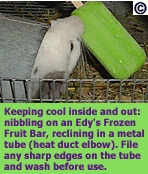
Chinchillas are NOT LIKE other furry critters that can survive periods of high heat and humidity! Whereas other furries may find it difficult but will manage to survive, high temperatures will outright KILL a chinchilla. This is because chinchilla fur density differs drastically from that of other animals, they have the highest fur density of any land animal in the world: 80-100 hairs per follicle (more than 20,000 hairs per square cm), while most fur-bearing animals have only 4-8 hairs per follicle. (ref- lszoo.org)
Fur density does vary by individual, and it can vary by species type as well. For instance, it is noted in the document “Chinchilla laniger“ that lanigeras have just 50-75 hairs per follicle (“from a single pore”), but even at only 50 hairs per follicle, that’s one HEAVY coat!
It is the chinchilla’s extreme fur density that makes them so incredibly sensitive to high heat and humidity. They MUST be kept inside a building (never outside where they would be exposed to the elements, temperature extremes, stray animals, etc.) with a temperature and humidity controlled environment that simulates the COOL and DRY climate of their native environment, the Andes mountains. There, the constant temperature is actually between 50-55 degrees Fahrenheit, but domestic chins have adapted to and should have it a bit warmer than that. (ref– New Hope Animal Hospital)
Be advised that domestic chinchillas (particularly one that is significantly underweight or severely fur bitten) CAN get chilled by temperatures that are too cold, especially if accompanied by drafts, and this will lower their resistance to sickness. We concur with New Hope Animal Hospital: “Ideal conditions are 60°F to 70°F with a humidity level of 40% to 60%.” (ref– New Hope Animal Hospital)
The temperature in a domestic chin’s environment should not exceed 70°F, and by 80°F, they’re facing brain damage, heatstroke, and death. When humidity is low the temperature can be at 70°F but when humidity is high, especially in summer, the temperature should be kept as close to the lower end of the temperature range (60°F) as air conditioning makes possible. You will need a device for your chinchilla’s room that features both temperature and humidity displays because both heat AND humidity must be constantly monitored.
An air conditioning unit, at least for the chin’s room, is an absolute NECESSITY, not a “luxury.” Be certain that the air conditioner you buy will restart automatically (as opposed to manual restart) if the power should fail momentarily so that a momentary power loss doesn’t leave the chins for hours on end without air conditioning. eBay often has an inexpensive window or portable units available, search by “air conditioner.” Even if it only reaches 70°F once or twice a year, for that day or two air conditioning will mean the difference between life and death to your chinchilla!
Note that a rotating or ceiling fan (which should never blow directly on the chinchilla) is only useful for circulating the cold air from an air conditioner. Fans alone will NOT keep your chinchilla cool because chinchillas do not sweat; fans also will not reduce humidity. Places with frequent high humidity (above 60%, common to coastal, peninsular and island locations especially) or chinchillas that are kept in the basement will require a dehumidifier. Besides the risk of overheating, high humidity creates conditions conducive to fungus.
Chinchillas that are accustomed to cooler temperatures (say, 60-65°F) are more immediately adversely affected by a sudden temperature change for the warmer (say, 70°F) than chins who are allowed time to acclimate to the warmer temperature.
Don’t forget when transporting your chinchilla that temperature and humidity must still be monitored. If they’re traveling via motor vehicle, it must be equipped with air conditioning and the chin’s carrier not placed in direct sunlight, covering the carrier with a small opaque sheet (no fringe, strings, or loose weave) during transportation will help.
Sunlight itself is good for chins, in fact, they’re known to sun themselves on rocks in the wild. HOWEVER, in the wild, they can get up and walk away when direct sunlight increases heat intensity beyond their ability to cope, whereas in captivity they are not in control of where their cage or carrier is placed. So be advised, sunlight is GOOD for chins just as long as it is not direct sunlight that is ALSO capable of causing an increase in heat intensity.
“Some small pets are susceptible to overheating, especially guinea pigs, chinchillas, and rabbits. Overweight animals, and those that have heavy fur, are also more prone to heat stress. Older and sedentary animals may also be more at risk, especially if they do not drink normal amounts of water.” (ref- peteducation.com)
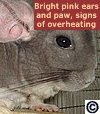
Signs of overheating include flushed (brighter pink, reddish) ears and paws, and the chin may stretch out on his side trying to get relief or lay on the bottom of his cage in an attempt to find a cool spot to rest in. Chinchillas do NOT “cool themselves” by “sending blood to their ears” or anything else, they are entirely dependent on their chinparent providing a climate-controlled (via air conditioning, dehumidifier) environment to prevent overheating, brain damage, heatstroke, and death. Be aware that chins sometimes naturally sleep on their sides and snuggling chins sometimes get flushed ears; to know whether it’s a possible case of overheating just check the temperature and humidity readings in the room.
“Pets with moderate heatstroke often recover without complicating health problems. Severe heatstroke can cause organ damage that might need ongoing care such as a special diet prescribed by your veterinarian. Pets who suffer from heatstroke once increase their risk for getting it again and steps must be taken to prevent it on hot, humid days.” (ref- peteducation.com)
If your chinchilla has succumbed to heat prostration- if he’s lying on his side, breathing laboriously and looks like he doesn’t care to go on living (this will differ from an instance of him peacefully stretched out and resting in this position)- then pick him up gently and keep him moving! Massage his limbs, lightly rub his head, because a chinchilla who is overheating and decides to give up will almost certainly die. Once he’s sufficiently revived, try the following:
NOTE: Using either of these suggestions may save your chinchilla’s life for the time being, however, you MUST take measures IMMEDIATELY to lower the temperature/ humidity in his environment or this temporary solution will be pointless! Also, do NOT apply rubbing alcohol to paw pads. This care myth is dangerous- applying rubbing alcohol to chinchilla skin will actually decrease the loss of heat from the body.
- Put a piece of cloth (no strings, fringe or loose weave) in the freezer to cover your frozen goods and to keep tender feet off cold metal, then place your chin in the freezer for up to five minutes at a time, leaving the freezer door slightly ajar so that you can supervise.
OR
- Mist or immerse the chin up to his neck in cool or lukewarm, NOT COLD, water. Coldwater could cause him to go into shock. When he perks up, dry him lightly with a towel in a cool room that has no open doors or windows, to prevent drafts. After the chin is thoroughly dry, give him lots of dust baths to roll in.
Keeping Cool During Hot/Humid Weather
NOTE: While these suggestions can provide some extra cooling relief for your chin, they are absolutely NOT a substitute for proper air conditioning and a dehumidifier! Cooling is most effective when a combination of inside and outside techniques are used simultaneously, thus cooling the chin from BOTH within and without.
Cooling from inside:
Edy’s Frozen Fruit Bars are good for nibbling and ice cubes can be set in the cage in a spill-proof bowl for licking. Be certain that your chin has a constant supply of cold water, put a full spare water bottle in the fridge, and switch it out with the one on the cage a few times a day.
Cooling from outside:
Allow your chinchilla access to at least a measuring cup full of fresh dustbath, placed in an appropriate container, for about 5-10 minutes every day during the warm weather season, or when high humidity is a factor. This will prevent his fur from becoming greasy, matted and heavy, which increases the danger of overheating.
Items that bring some cooling relief after time in the freezer: dust bath in a metal or ceramic container, terra cotta planter, Chin-Chillers, metal tube. We’ve noticed that ceramic and metal don’t retain their coolness for nearly as long as terra cotta or the granite slab sometimes referred to as a “Chin-Chiller.”
Fill a quart or gallon size Ziploc freezer bag with ice, then put that in a pillowcase or wrap it in another type of thin cloth (no strings, fringe or loose weave) and place it in the cage. Wrapping a freezer pack also works; the pillowcase or cloth will prevent the chin chewing on the plastic of either the Ziploc bag or freezer pack. Condensation can make the cloth damp and subsequently the chin as well, so keep a dust bath handy so the chin can keep dry.
Related Video:
Estimating Chinchilla Age
It is not clinically possible to tell the exact age of a chin by an on-the-spot physical examination. In the absence of relevant documentation, the best that can be done is an estimation of age, and that doesn’t deliver exact results. Rescuers whose incoming chins manifest wounds or fur biting can use this system of estimation to give potential adopters an idea of a chin’s age range but otherwise, we discourage deliberately conducting an age estimation (by the fur regrowth indicator) unless for some reason it becomes necessary for the chin’s sake.
Healing rate and/ or fur regrowth make it possible to estimate chinchilla age because as chins’ bodies age, their healing rate and fur regrowth slow. HOWEVER, these indicators are significantly influenced by both past and present care (good nutrition, safe bedding and chew toys, etc.) and recent stress levels.
For example, a chin that was kept on cedar bedding and fed potential health hazards (yellow and red arrows) on a daily basis for the first years of his life or who is currently being harassed by another household pet will have inaccurate age estimation results because healing rate and/ or fur regrowth are slowed when negative care and stress factors are involved.
When a chin is in good health, has received proper care for at least a year and his stress levels are low, then the indicators of age are, according to healing rate/ fur regrowth estimation:
- A young (1-4 years) chin heals/ regrows in a matter of about 2-3 weeks
- A middle-aged chin (5-7 years) heals/ regrows in about 4-6 weeks
- A senior (8 years and up, from our research chinchilla life expectancy in the wild, is only eight years old) can take about 6 weeks to heal/regrow and with much older chins, those in their teens, it can take up to a matter of several months to heal/regrow. This is what makes surgery so dangerous for senior chins, they may die from complications that result from their slow healing rate.
Besides healing rate and/ or fur regrowth, middle-aged and senior chins are more likely to have scales on their ears from untreated dry skin and advanced callouses (flippers) from untreated callouses. Seniors, especially those past age eight, frequently have poor eyesight, Nuclear Sclerosis, or cataracts.
Shipping, Transporting Or Travelling With Your Chin
- Be sensitive to the possibility, if your chin has come from a rescue/ rehoming background, that he will associate travel with the stress of being unwanted, of relocation and adjustment. Other chins associate it with vet visits and in either case, the chin may be very stressed and should receive as much comfort and reassurance as possible during the trip.
- Remember that the temperature for the ENTIRE TIME during transportation must not exceed 70°F (with humidity at 40-60%), also keep the chin’s carrier out of direct sunlight.
- A plastic carrier WILL get chewed and a chin kept in one for very long can eventually gnaw his way out. Wire mesh carriers are best.
- If you don’t have a drop-bottom carrier, put a cloth (no fringe, strings, or loose weave) on the bottom of the carrier so the chin has something soft to rest on that will also prevent him from getting soaked if he urinates.
- Only give the chin distilled or filtered water at stops unless you have a no-leak water bottle, to prevent him and the carrier interior from getting soaked.
- Avoid cluttering carrier space with a food dish or too many chew items that will only get spilled or soiled beyond use. Instead, provide the chin with one hay cube so that he has something to eat, and one small chew toy so that he has something to do; this will help relieve the stress of traveling.
- Keep the carrier covered with an opaque sheet (no fringe, strings, or loose weave) to help the chin feel less exposed and vulnerable during travel.
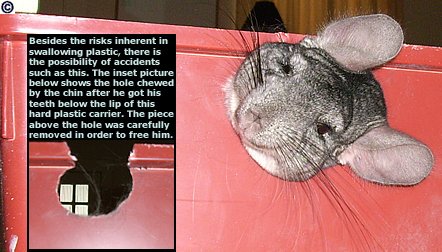
Related Video:
Chinchillas And Allergies: Not “Hypoallergenic”
Animal proteins, not found in dander alone, are now believed to be the chief cause of allergic reactions by pet owners. Chinchillas don’t have dander, but the potential still exists for them to produce allergy-causing proteins through other excretions, such as saliva or urine. Chinchillas do shed (and regrow) their fur, but very subtly, in almost unnoticeable amounts approximately every few months. But probably the biggest problem to people with allergies is the generous amounts of hay and dust that chinchillas use regularly, those items being common allergy irritants.
If you are allergic to hay or dust, please don’t choose a chinchilla for a pet. “I’m allergic” is one of the top reasons that chinchillas are surrendered to rescue, often after having been long-deprived of hay or dust bath to accomodate their owner’s problem; this is grossly unfair to the chinchilla who requires hay and dust for health reasons. To quote from one rehoming request received by us in our rescue work, “Before getting them we were under the impression that they were a good pet for people with allergies. This is a totally wrong assumption. Since getting them I’ve gone from having regular hay fever to needing an emergency inhaler, to needing a steroidal inhaler.”
allergiesexplained.com describes a case where a woman was allergic to the chinchilla itself:
“Any pet can cause a problem, and a special testing solution may not be available. A good example is a lady who developed rhinitis with very severe sneezing attacks. Her little boy had been given a chinchilla for his birthday sometime before she developed her problem, and she got better on holiday. The chinchilla is a rodent from South America which can be used to make very expensive fur coats.
“Because skin tests for dust mite and all common allergens were negative she was asked to come back with a sample of the animal’s hair, and also some house dust collected from the top of the wardrobe. She brought only a few wisps of hair, but this was enough to make an extract in a syringe that produced an immediate skin reaction, and so did an extract of the dust from the top of the wardrobe., as shown, but the usual dust-mite test was negative. Fortunately, she was soon to move house, so it was advised that the chinchilla be kept outside after they moved to the new house, and there was no further trouble with allergic rhinitis.” [Note by ChinCare: Chinchillas should never be kept outside!! This unfortunate chinchilla should have been taken to rescue immediately for rehoming.]
While the following resources discuss animal proteins and allergies, they do not name chinchillas specifically and are intended as a general orientation:
“It was once thought that these people were allergic only to dander and cat hair, however, it is now believed that these people might actually be allergic to protein particles that are found in various body fluids such as saliva, sweat (and yes, cats can sweat) and urine.” (ref- catrescue.ca, archived article)
“All warm-blooded, furry animals, such as the average household pet, can cause allergic reactions, usually because of proteins in their saliva, dander, and urine. When the animal licks itself, the saliva gets on the fur. As the saliva dries, protein particles become airborne and work their way into fabrics in the home.” (ref– kidshealth.org, search “allergy”)
“Rodent Allergy: Patients become allergic to rodents due to exposure to these animals in their daily work. The most common people at risk are veterinarians, laboratory technicians, and people who live in close quarters with rodents (such as pet owners and those who live in rodent-infested homes). Some examples of common rodents that humans come in contact with include mice, rats, and guinea pigs. The rodent’s urine has a high concentration of protein, which is the primary allergen to humans. The urine is often sprayed rather than deposited, thereby increasing human exposure. After the urine dries, the urinary proteins become airborne and are inhaled, leading to allergic symptoms.” (ref- theallergyauthority.com, web.princeton.edu)
“How Do Animals Cause Allergies? When we touch or work around animals, we expose our bodies to these allergens. The allergens, which we contact from animals, are called antigens and are transferred to us merely by inhaling, eating, rubbing our eyes, or touching our skin. Common animal antigens are as follows:
- Cats-saliva, hair, skin dander, albumin (a blood protein).
- Dogs-saliva, hair, skin dander, albumin.
- Guinea pigs-urine, skin dander, hair, saliva.
- Rabbits-fur protein, saliva, urine.
- Rats-urine, saliva, bedding, albumin.
- Mice-urine, albumin.
- Pigs-urine.
- In addition, gerbils, cattle, horses, sheep, deer, birds, reptiles, and fish can cause allergic reactions.
“Symptoms of an animal allergy can occur right after exposure; or a person can become allergic after weeks, months, or years of exposure.” (ref- utmem.edu)
Reducing the Allergic Impact of Hay and Dust
This article is intended for people who are considering a chinchilla as a pet or who have a chinchilla as a pet and who are NOT normally allergic to hay and dust. If you ARE normally allergic to hay and dust, a chinchilla is not a suitable pet for you.
Especially if one has had chinchillas for awhile, it’s not unusual to develop a greater sensitivity to the dust and hay they continually use, dust in particular as it seems to find its way everywhere. We even know of rescuers and breeders who had housed large numbers of chinchillas for years and who had to close their doors and rehome their chinchillas due to allergy problems. While it may be possible to reduce the impact of hay and dust on allergies, nothing can be done if one is allergic to allergy-causing proteins in the chinchilla himself, in that case rehoming is the only option.
Firstly, get an air purifier and put it in your chin’s room: The Technology of Air Purifiers, Compare Air Purifiers
To minimize the impact of dust from a chin’s regular need to bathe, follow these suggestions to the extent your situation allows you to: Keep your chin’s cage covered with a sheet. Keep the chin’s cage in a room that you can close the door to. When administering dust, turn off any fans in the chin’s room, put the dust bath container in the chin’s cage and draw the sheet around his cage and then leave the room, closing the door behind you. Return in about fifteen minutes when the chin’s dust has mostly settled.
There are several brands of dust available in the U.S. (Blue Cloud, Blue Sparkle, Kaytee, Sunseed, etc.) and from what we’ve been told, the dust used in the U.S. is of a much finer consistency than that found overseas, where it is more granular and is sometimes referred to as “sand bath.” The finer the dust, the more potentially aggravating it is to human sinuses. If you have the opportunity to choose between Blue Cloud and Blue Sparkle dust, although they are both of a fine consistency, Blue Sparkle is somewhat less fine.
Super Pet Chinchilla Bath Sand is available in the U.S. and this product does greatly reduce the typical clouds of flying dust, but it has a very gravelly consistency and because of that, some chins may not use it. Also, it’s fur cleaning ability is debatable and it usually takes more than one packet for there to be enough sand to bathe in, making it potentially less cost-effective than other dust.
To help reduce sensitivity to hay, wash your hands after handling hay and keep it stored in the chin’s room where the air purifier is active. Consider providing chiefly hay cubes as a hay source because they have less dust than loose hay.
Related Video:

